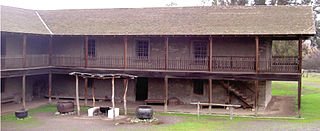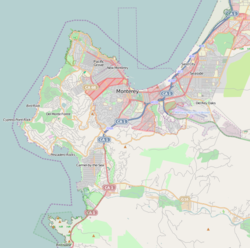
Monterey State Historic Park is a historic state park in Monterey, California. It includes part or all of the Monterey Old Town Historic District, a historic district that includes 17 contributing buildings and was declared a National Historic Landmark in 1970. The grounds include California's first theatre, and the Monterey Custom House, where the American flag was first raised over California.

The Cathedral of San Carlos Borromeo, also known as the Royal Presidio Chapel, is a Roman Catholic cathedral located in Monterey, California, United States. The cathedral is the oldest continuously operating parish and the oldest stone building in California. It was built in 1791-94 making it the oldest serving cathedral in the United States, along with St. Louis Cathedral in New Orleans, Louisiana. It is the only existing presidio chapel in California and the only existing building in the original Monterey Presidio.

Rancho Petaluma Adobe is a historic ranch house in Sonoma County, California. It was built from adobe bricks in 1836 by order of Mariano Guadalupe Vallejo. It was the largest privately owned adobe structure built in California and is the largest example of the Monterey Colonial style of architecture in the United States. A section of the former ranch has been preserved by the Petaluma Adobe State Historic Park and it is both a California Historic Landmark and a National Historic Landmark. The Rancho Petaluma Adobe State Historic Park is located on Adobe Road on the east side of the present-day town of Petaluma, California.

The José María Alviso Adobe, located in Milpitas, California, United States, was the home of José María Alviso, an early alcalde (mayor) of neighboring Pueblo de San Jose. It was built in 1837 and enlarged in the early 1850s, and stands as an excellent example of the Monterey Colonial style of architecture popularized throughout California in the 1830s and 1840s. It is the only remaining example of this style in the Santa Clara Valley and San Francisco Bay Area. The adobe is listed on the National Register of Historic Places.

The José Castro House, sometimes known as the Castro-Breen Adobe, is a historic adobe home in San Juan Bautista, California, facing the Plaza de San Juan. The Monterey Colonial style house was built 1838-41 by General José Antonio Castro, a former Governor of Alta California. It was later sold to the Breen family, who lived there until 1933, when the house became a museum as part of San Juan Bautista State Historic Park.

Los Cerritos Ranch House, also known as Rancho Los Cerritos or Casa de los Cerritos, in Long Beach, California, was "the largest and most impressive adobe residence erected in southern California during the Mexican period". Los Cerritos means "the little hills" in English. It was declared a National Historic Landmark in 1970.

San Juan Bautista State Historic Park is a California state park encompassing the historic center of San Juan Bautista, California, United States. It preserves a significant concentration of buildings dating to California's period of Spanish and Mexican control. It includes the Mission San Juan Bautista, the Jose Castro House, and several other buildings facing the historic plaza. It became a state park in 1933 and was declared a National Historic Landmark in 1970. It is also a site on the Juan Bautista de Anza National Historic Trail.

The Larkin House is a historic house at 464 Calle Principal in Monterey, California. Built in 1835 by Thomas O. Larkin, it is claimed to be the first two-story house in all of California, with a design combining Spanish Colonial building methods with New England architectural features to create the popular Monterey Colonial style of architecture. The Larkin House is both a National and a California Historical Landmark, and is a featured property of Monterey State Historic Park.

Monterey Colonial is an architectural style developed in Alta California. Although usually categorized as a sub-style of Spanish Colonial style, the Monterey style is native to the post-colonial Mexican era of Alta California. Creators of the Monterey style were mostly recent immigrants from New England states of the US, who brought familiar vernacular building styles and methods with them to California.

The Old Custom House is the oldest surviving government building in California, built in 1827 by Mexican authorities in Monterey, then the capital of Alta California. The former custom house is the first designated California Historical Landmark, marking the site where U.S. Commodore John Drake Sloat raised the American flag and declared California part of the United States in 1846 during the American Conquest of California.

This is a list of the National Register of Historic Places listings in Monterey County, California.
Merritt House may refer to:

The Jose Eusebio Boronda Adobe is a Monterey Colonial style building from 1846, located in Salinas, Monterey County, California.

The Josiah Wilcox House is a historic house at 354 Riversville Road in Greenwich, Connecticut. Built in 1838, it is one of the town's finest examples of Greek Revival architecture. It was listed on the National Register of Historic Places in 1988.
In the United States, the National Register of Historic Places classifies its listings by various types of architecture. Listed properties often are given one or more of 40 standard architectural style classifications that appear in the National Register Information System (NRIS) database. Other properties are given a custom architectural description with "vernacular" or other qualifiers, and others have no style classification. Many National Register-listed properties do not fit into the several categories listed here, or they fit into more specialized subcategories.

The Mary C. W. Black Studio House, located at 556 Abrego St. in Monterey, California, is a historic house and artist's studio that is listed on the National Register of Historic Places. It was purchased in 1925 by Monterey artist Mary Corning Winslow Black (1873–1943), who completed her redesign of the old adobe in 1930, including the addition of "sumptuous gardens." It is an example of eclectic architecture including Mission/Spanish Revival architecture and its substyle of Monterey architecture.

The Samuel M. Black House, located at 418 Pajaro St. in Salinas, California, is a historic Queen Anne style house that is listed on the National Register of Historic Places.

The James W. Finch House, known also as the Finch-Fleischer House, is a historic house in Monterey, California that is listed on the National Register of Historic Places (NRHP).

The Stevenson House, is a historic two-story Spanish Colonial style building located at 530 Houston Street in Monterey, California. It was a boarding house called the French Hotel, built circa 1836. The Scottish author Robert Louis Stevenson lived there in 1879, writing and courting his future wife. It is now a museum and property of the Monterey State Historic Park. The building was listed on the National Register of Historic Places on January 7, 1972. The building is also listed as a California historical landmark #352.






















